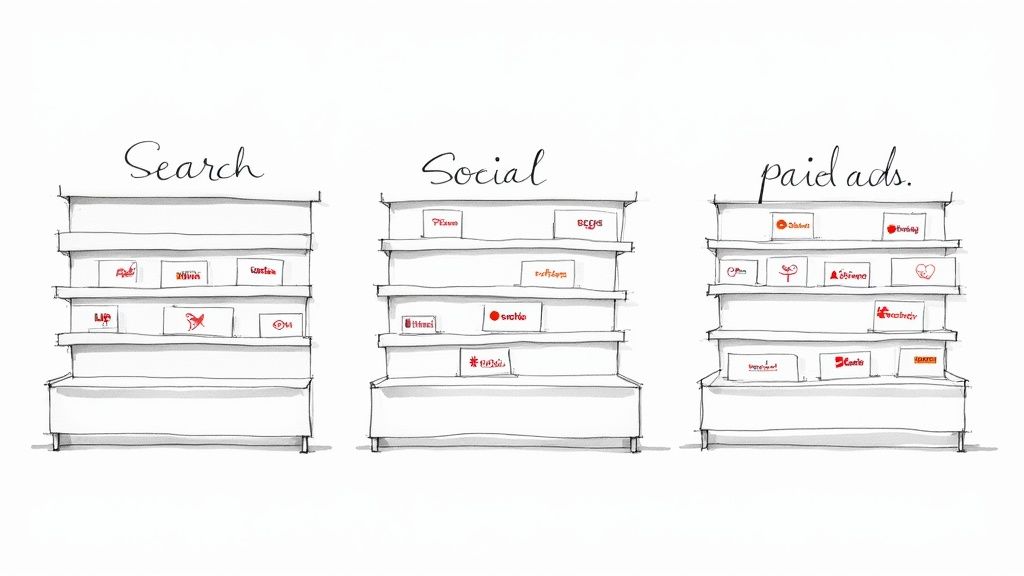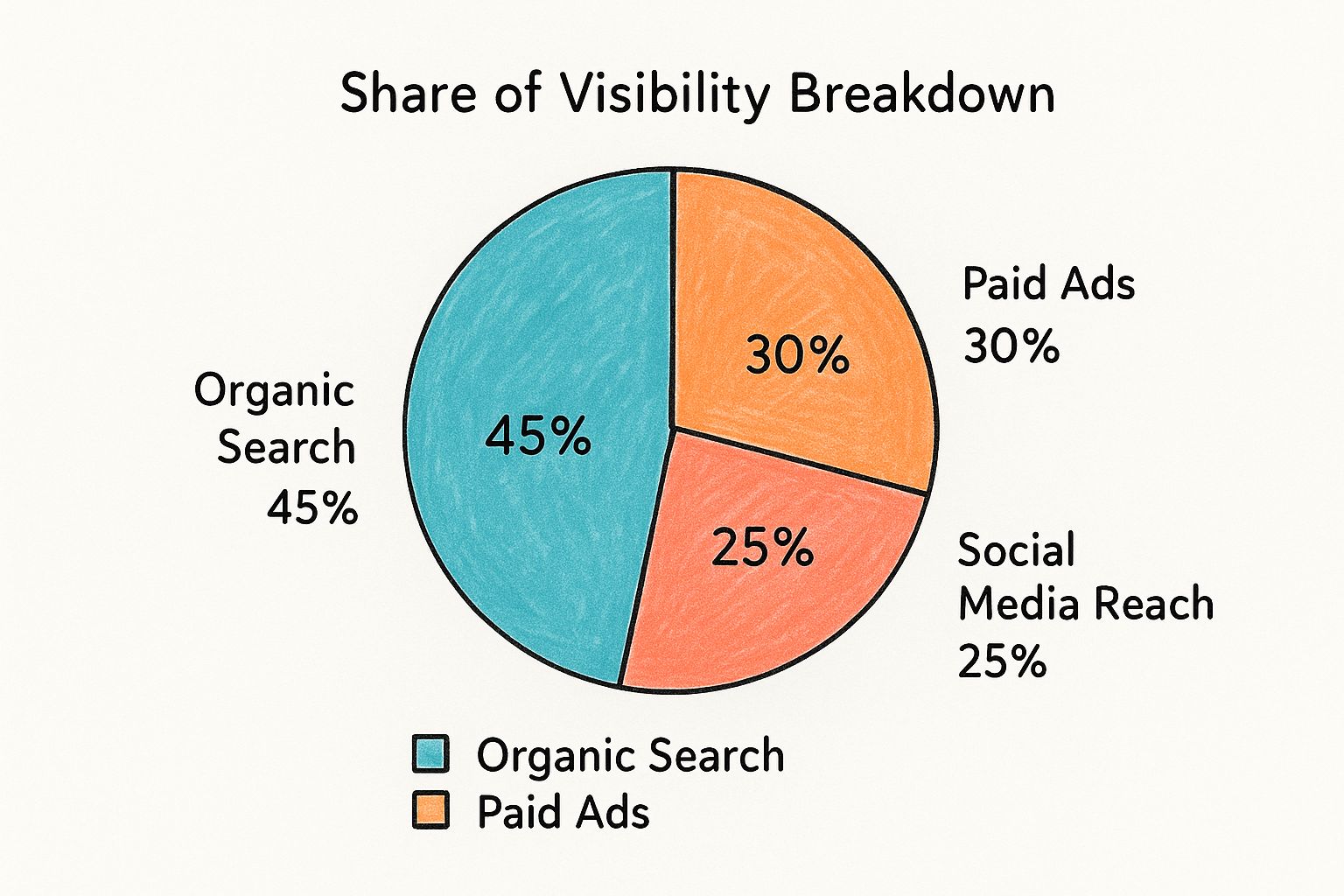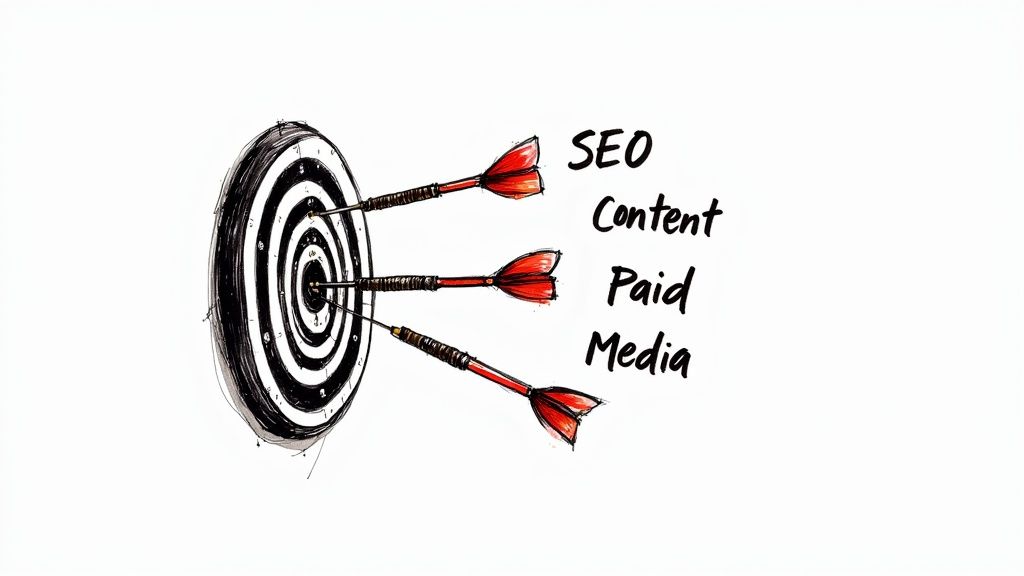Mastering Share of Visibility to Dominate Your Market

Maxime Dupré
10/20/2025

What Is Share of Visibility and Why It Matters More Than Rankings

Let’s imagine your entire market is one giant digital supermarket. For years, SEOs have obsessed over rankings, which is like knowing exactly which shelf your product is on. You might be on the top shelf for one specific keyword, but what about the rest of the store? That’s where the old model falls short.
Share of Visibility (SOV) gives you the complete floor plan. It tells you how much of the entire supermarket your brand actually occupies. It's the true measure of your presence across every single aisle—from organic search and social media to paid ads and beyond.
This metric helps you graduate from the vanity of a single #1 ranking. Instead, it measures your brand’s actual dominance compared to everyone else vying for the same customer's attention. After all, real influence isn't just about being seen once; it's about how often and consistently you show up wherever customers are looking.
The Problem with Chasing Rankings
Fixating on individual keyword rankings is like looking at the market through a keyhole. You might be celebrating a top spot for "blue running shoes" while your competitors are quietly capturing the audience across hundreds of other related searches. You’re winning a single skirmish but losing the broader battle for market control.
SOV, on the other hand, provides a strategic, bird's-eye view of your competitive standing by pulling together data from all the places your customers hang out online.
A high ranking is a data point. A high Share of Visibility is a competitive advantage. It proves you’re not just part of the conversation—you’re driving it.
Getting a handle on this metric is the first real step toward building a digital strategy that can win. It forces you to stop navel-gazing at your own analytics and start analyzing the entire competitive landscape. This is a fundamental part of effective competitive intelligence, where the goal is simply to see the market the way your customers do.
What SOV Actually Measures
Share of Visibility isn't a single, simple number. It's a powerful composite metric that blends several key indicators to give you a holistic picture of your market footprint.
- Organic Search Presence: This isn't just about one or two keywords. It evaluates your visibility across a wide basket of relevant terms, often weighted by search volume to reflect real-world traffic potential.
- Paid Ad Dominance: In the world of paid advertising, SOV is closely tied to Impression Share—the percentage of times your ads appeared out of the total number of times they could have appeared.
- Social Media Conversation: It also gauges your slice of the pie in online discussions, measuring how often your brand is mentioned compared to your top competitors.
By tracking your SOV over time, you create a powerful benchmark for real growth. The goal shifts from just climbing the search results to systematically claiming more digital shelf space, until your brand becomes the most obvious and trusted choice for your audience.
How to Calculate Your Share of Visibility
Figuring out your share of visibility might seem like a data-heavy nightmare, but it’s more straightforward than you think. At its core, it's about stacking your brand’s presence up against the competition across the channels that matter most. You don't need to be a data scientist—you just need to know what to measure.
Think of it as creating a map of your market. We'll gather data from the main battlegrounds where your customers are paying attention: organic search, paid advertising, and social media. Each channel has its own rules, but putting them all together gives you a crystal-clear view of your footprint.
This breakdown shows how a typical brand's visibility might be split. It's rarely all in one place.

As you can see, a strong visibility strategy is usually diversified. Organic search often represents the biggest slice because it's a long-term, sustainable asset.
While the concept is the same everywhere—your share versus the total—the specific metrics and formulas change depending on the channel.
Let's look at the most common methods for calculating SOV.
| Channel | Key Metric | Calculation Formula |
|---|---|---|
| Organic Search | Clicks or Traffic | (Your Estimated Clicks ÷ Total Estimated Clicks for Tracked Keywords) x 100 |
| Paid Ads (PPC) | Impression Share | (Your Ad Impressions ÷ Total Eligible Impressions) x 100 |
| Social Media | Brand Mentions | (Your Brand Mentions ÷ Total Industry Mentions) x 100 |
These formulas give you a concrete number to work with, turning a vague idea like "market presence" into something you can actually track and improve.
Diving Into the Channels
Let's break down how this works in practice for each area.
Organic Search
For organic search, SOV is about more than just your ranking. It's about how much of the actual traffic you're capturing from the search results page for your target keywords.
The simple way to think about it is:
(Your Brand's Clicks for a Keyword Set) / (Total Clicks for a Keyword Set) = Organic SOV
Here's how you can get started:
- Define Your Keyword Basket: First, pull together a list of the important, non-branded keywords your audience is searching for. This is your battleground.
- Track Rankings: Use an SEO tool to see where you and your competitors rank for every keyword in that basket.
- Estimate Traffic: This is the key step. You’ll multiply each keyword’s monthly search volume by the estimated click-through rate (CTR) for its ranking position. A #1 spot gets way more clicks than a #8 spot.
- Calculate Your Share: Finally, add up all your estimated traffic and divide it by the total estimated traffic for everyone you’re tracking. Boom—that's your share.
Paid Ads and Social Media
Things get a bit more direct with paid ads and social media because the platforms often give you the exact metric you need.
Paid Ads (Impression Share): In the world of Google Ads, your share of visibility is called Impression Share. It’s the percentage of times your ads were shown out of the total times they could have been shown. If your Impression Share is 40%, you know for a fact your competitors are gobbling up the other 60%.
Social Media (Share of Voice): Here, you're measuring your share of the conversation. It involves tracking how many times your brand is mentioned compared to your competitors. The formula is simple: (Your Brand Mentions) / (Total Industry Mentions) = Social SOV.
Pulling all this data together manually is a huge time sink, which is why most teams use specialized tools to automate the process. You can find some great options in guides that review the best competitive intelligence software on the market. Using the right platform means less time spent in spreadsheets and more time acting on the insights.
Why Share of Search Predicts Future Market Share

While your overall share of visibility gives you the full lay of the land, one specific piece of it acts like a crystal ball for future growth: Share of Search. This metric zeroes in on the organic search channel to figure out how many people are looking for your brand compared to your competitors. It's the most direct way to measure consumer interest and brand relevance.
Think about it. What’s the very first thing most people do when they have a problem or a need? They head straight to a search engine. The brands that dominate these initial queries are essentially becoming the go-to answer in the customer's mind, long before a purchase is ever made.
This simple act of someone typing your brand name into a search bar is an incredibly powerful leading indicator. If your share of search is on the rise, it’s a clear sign that your marketing is hitting the mark and brand recall is growing. That buzz almost always translates into more sales and a bigger slice of the market down the line.
The Connection Between Search and Sales
The link between what people search for and what they end up buying is undeniable. That’s why Share of Search is much more than just an SEO metric—it’s a business intelligence tool that gives you a real-time read on your brand's health.
Tracking your Share of Search is like having an early warning system for market shifts. It shows you whether you’re gaining or losing ground in the minds of your customers long before those changes ever show up in a sales report.
This metric cuts through all the noise of clicks and impressions to measure what really matters: brand salience. When more people are searching for you by name, it means your brand is becoming synonymous with the solution they’re looking for. It's the ultimate proof that your message is resonating.
Putting Share of Search into Practice
In practice, share of search is pretty straightforward. You're calculating the percentage of all branded searches in your industry that belong to you. For example, a giant like Apple would look at the search volume for "Apple" and compare it to the volume for competitors like "Samsung" and "Google."
The real power here is its ability to forecast market share. Time and again, we see a significant rise in a brand's share of search happen just before a corresponding jump in their sales. As more companies catch on, it’s becoming a go-to metric for gauging consumer interest, as detailed in this analysis from Exploding Topics.
By keeping a close eye on this metric, you can start making smarter moves.
- Validate marketing campaigns: Did that big ad spend actually make more people curious about your brand? Your share of search will tell you.
- Anticipate competitor moves: If a rival's share of search starts climbing, it's time to dig in and see what they're doing right.
- Forecast future demand: Spotting trends in search behavior can help you predict sales cycles and get ahead of inventory needs.
Ultimately, tracking this key part of your overall share of visibility helps you stop reacting to the market and start predicting it. It gives you the foresight you need to win.
Expanding Your Visibility Beyond Google Search
Getting a high rank on Google feels like a massive win, and it is. But in today's world, it’s just one piece of a much larger puzzle. Customers now find brands everywhere—from their social media feeds to niche community forums. These platforms have become powerful discovery engines, and your share of visibility needs to reflect that reality.
If you’re only focused on traditional search, you’re missing out on huge segments of your audience right where they spend their time. The modern customer journey is rarely a straight line that starts and ends with a Google search. It’s a winding path that weaves through TikTok, Instagram, LinkedIn, and countless other channels where people look for recommendations, research products, and decide who to trust.
Meeting Customers Where They Are
The shift in how people discover things is undeniable. Social media is no longer just for connecting with friends; it's a primary channel for brand discovery. In fact, a staggering 58% of consumers now find new businesses through social platforms, easily blowing past traditional search and TV. When you consider that people spend an average of 141 minutes a day on social media, you realize it's a constant stream of opportunities to grab their attention. You can dig into more stats on how social media is reshaping marketing over at Sprinklr.com.
This trend calls for a much more connected strategy. Your search and social efforts can't live in separate silos. They need to work together to build a strong, cohesive brand presence that appears wherever your audience is looking for answers.
Share of visibility is about owning the digital shelf space your customers browse every day, not just the one they visit when they’re ready to buy. It's a measure of influence across their entire journey.
This means you have to tailor your approach to the unique vibe of each platform. For example, to truly diversify your online presence, think about a platform like Pinterest. By mastering Pinterest SEO and keywords, you can tap into a visually-driven audience that's actively looking for inspiration and new products.
Measuring Visibility on Different Platforms
When you start looking beyond search, the way you measure share of visibility has to change, too. Instead of just tracking clicks and rankings, you need to focus on metrics that capture engagement and conversation.
- Social Mentions and Hashtag Usage: How often is your brand being talked about? Track mentions and the use of your branded hashtags compared to your competitors. This gives you a direct look at your share of the conversation.
- Impression Share on Paid Social: Just like with search ads, platforms like Meta and LinkedIn can tell you how many people your ads reached versus the total potential audience. The principles behind paid search intelligence can offer some great parallels for getting the most out of your social ad budget.
- Video Views and Engagement: On platforms like YouTube and TikTok, your share of visibility is all about views and engagement—likes, comments, and shares—on topics and keywords that matter to your audience.
By widening your view of visibility, you go from simply being findable to being genuinely present in your customers' digital lives. This multi-platform approach is crucial for building a resilient brand that can capture attention and drive growth, no matter where the audience is.
Actionable Strategies to Increase Your Share of Visibility

Knowing your share of visibility is one thing, but actually growing it is how you start to dominate your market. This is where you shift from analysis to action, creating a smart plan that targets the channels where your audience is already active. Think of it as methodically expanding your digital territory, pushing your competition further and further out of the frame.
Each strategy we'll cover is a game plan designed to help you claim more of that territory. Whether you lean on clever SEO, authoritative content, or efficient ad spending, the end goal is always the same: become the most recognized and trusted voice in your space.
Master the Search Engine Results Page
Dominating organic search is the foundation of any solid SOV strategy. This isn't just about snagging the top spot for a few vanity keywords. It's about owning the entire search results page (SERP) for the topics that drive your business forward and building visibility that lasts.
A great place to start is by targeting your competitors' keywords. Use your favorite SEO tool to uncover the high-value terms your rivals are ranking for that you aren't. From there, your mission is to create far superior content that better answers the searcher's intent—it's a direct way to siphon off their traffic and boost your own visibility.
For a deep dive into building a commanding presence, this guide on SEO for SaaS companies offers a fantastic roadmap for sustainable growth.
But don't stop at the classic blue links. Your goal should be to capture as many SERP features as possible:
- Featured Snippets: To grab that coveted "answer box" at the top, write clear, concise answers to common questions directly in your content.
- Video Carousels: If you're creating video, optimize it for search. A well-optimized video can land you a spot in the prominent video carousels.
- "People Also Ask" Boxes: Structure your articles with subheadings (H2s, H3s) that mirror common questions. This dramatically increases your odds of appearing in these expandable Q&A sections.
Build Authority with Pillar Content
Content marketing is your engine for establishing topical authority. Instead of just publishing random blog posts, the real power comes from creating pillar pages—these are comprehensive, definitive guides on core topics within your industry. A well-crafted pillar page serves as the central hub for an entire subject.
This approach brings structure and focus to your content strategy, positioning your website as the ultimate resource for a given topic. For instance, a company selling project management software might create a pillar page on "Agile Methodology." This central page would then link out to more specific articles, like "Scrum vs. Kanban" or "How to Write Effective User Stories."
By building a comprehensive resource hub, you signal to search engines that you are an authority on the subject. This not only boosts your rankings across a cluster of related keywords but firmly establishes your brand as a market leader in the minds of your customers.
This strategy also creates a powerful internal linking structure, which helps spread authority across your site and improves your visibility for dozens of valuable long-tail keywords. You're no longer just trying to rank for a single term; you're aiming to own the entire conversation around a topic.
Maximize Your Paid Media Impression Share
When it comes to paid media, the name of the game is maximizing your Impression Share without lighting your budget on fire. This metric, particularly in Google Ads, is the most direct equivalent to your share of visibility in paid search. An impression share of 70% literally means your ads are showing up in 7 out of every 10 searches you're eligible for.
Here’s how you can boost that number efficiently:
- Increase Your Budget: This is the most straightforward lever to pull, but it's not always the wisest first move. Only consider this after you've optimized everything else.
- Improve Your Quality Score: Google rewards ads that are highly relevant to the search query. A better Quality Score lowers your costs and helps your ads show more often, even on the same budget.
- Refine Your Bidding Strategy: Don't be afraid to use automated bidding strategies. Setting a "Target Impression Share" tells Google's algorithm exactly what your visibility goal is.
- Expand Keyword Targeting: Add relevant long-tail keywords to your campaigns. These less-common phrases allow you to enter more ad auctions without paying the premium for hyper-competitive head terms.
Deciding which strategy to prioritize depends on your resources and long-term goals. SEO and content build lasting authority, while paid media offers immediate visibility.
Strategy Comparison for Boosting Share of Visibility
| Strategy | Primary Focus | Effort Level | Expected Impact on SOV |
|---|---|---|---|
| Competitive SEO | Ranking for competitor keywords & SERP features | High | High (Long-term, sustainable) |
| Pillar Content | Establishing topical authority & owning a niche | High | High (Long-term, compounds over time) |
| Paid Media Optimization | Increasing Impression Share in paid ads | Medium | High (Immediate, budget-dependent) |
| Social Media Engagement | Increasing brand mentions & conversation share | Medium | Medium (Builds brand recall & loyalty) |
Ultimately, a balanced approach often yields the best results. By combining these strategies, you create a powerful, multi-channel presence that makes your brand impossible to ignore.
Got Questions About Share of Visibility?
Once you start thinking about share of visibility, a few practical questions always come up. It's one thing to understand the concept, but another to actually measure and improve it. Let's tackle some of the most common ones I hear from teams just getting started.
Think of this as the practical, real-world FAQ. These are the details that will help you move from theory to a smart, actionable strategy.
How Often Should I Be Measuring This?
This is a great question, and the answer really depends on how fast your industry moves. There's no single right answer, but you can definitely find a rhythm that works for you.
For most businesses, checking in monthly or quarterly is the sweet spot. This cadence is frequent enough to catch important shifts but not so frequent that you're just reacting to normal, everyday noise in the data.
- Monthly Tracking: A good idea for fast-paced industries, or when you're in the middle of a big marketing push or product launch. It lets you be more nimble and respond quickly to what competitors are doing.
- Quarterly Tracking: Perfect for more stable markets. This gives you a clearer view of long-term trends and helps you gauge the real impact of your bigger strategic plays over time.
The most critical thing? Be consistent. Pick a schedule and stick with it. The real power of this metric comes from tracking your progress over time.
What’s a “Good” Share of Visibility Score?
I get asked this all the time, and the answer is surprisingly straightforward: it's completely relative. There is no magic number or universal "good" score to shoot for. Your SOV is all about how you stack up against your specific competitors.
A "good" score isn't some arbitrary percentage—it's being more visible than your direct rivals. A 20% SOV could make you the undisputed leader in a market with ten competitors, while 60% might be lagging if you're in a two-horse race.
Instead of getting hung up on a number, shift your focus to these goals:
- Show consistent growth, whether you're tracking month-over-month or quarter-over-quarter.
- Outpace your closest competitors on the channels that your audience actually uses.
- Become the top dog in your specific niche or category.
Your main goal should always be to beat the competition. You want to be the brand that customers see first and think of most often.
Can a Small Business Actually Compete on SOV?
Yes, 100%. In fact, share of visibility can be a small business's secret weapon. The trick is to play smarter, not harder. You can't go head-to-head with industry giants on every single front—their budgets are just too big.
So, don't. Instead of fighting for broad, hyper-competitive keywords like "project management software," a smaller company can completely own a niche. Imagine focusing all your energy on dominating the search results for "agile tools for remote creative teams."
By narrowing the battlefield, you can pool your resources and build a commanding presence where it truly counts. This is how you win. You become the best, most visible solution for a very specific problem, and you start peeling customers away from bigger competitors who are trying to be everything to everyone. It’s a classic case of strategy trumping size.
Monitoring your ChampSignal dashboard is the first step to understanding where you stand. With automated tracking of your competitors' SEO, ads, and brand mentions, you can finally get a clear picture of your share of visibility and identify opportunities to grow it. See how you stack up with a free 30-day trial at champsignal.com.
Get Started
Competitor Monitoring That Doesn't Suck
Spend under two minutes per week monitoring your competitors. Receive only the information that matters.
Join startup founders two steps ahead of their competition.

